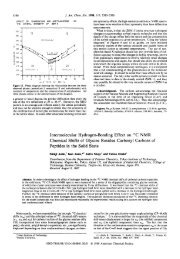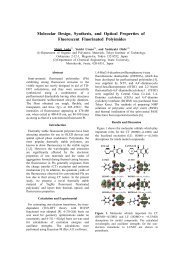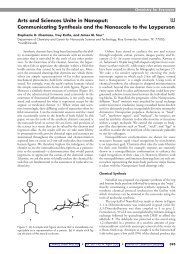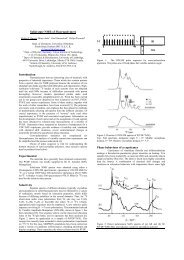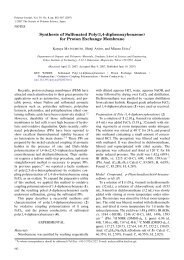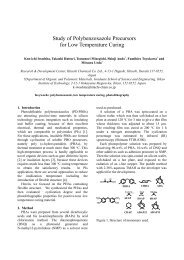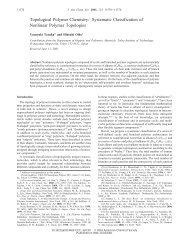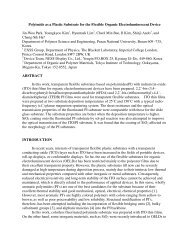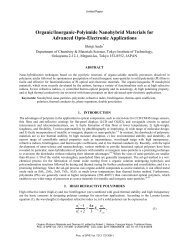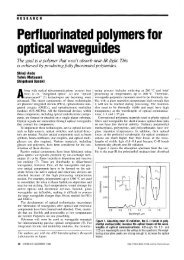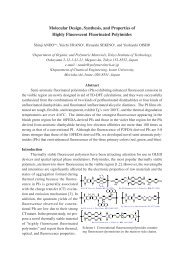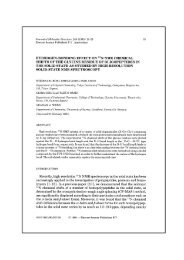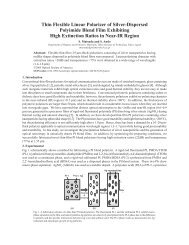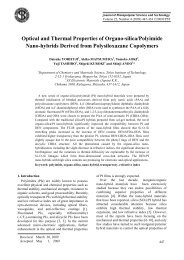Polymers for Microelectronics
Polymers for Microelectronics
Polymers for Microelectronics
Create successful ePaper yourself
Turn your PDF publications into a flip-book with our unique Google optimized e-Paper software.
A C S S Y M P 0 S I U M S E R I E S 537<br />
<strong>Polymers</strong> <strong>for</strong> <strong>Microelectronics</strong><br />
Resists and Dielectrics<br />
Larry F. Thompson, EDITOR<br />
AT&T Bell Laboratorzes<br />
c. Grant Willson, EDITOR<br />
The University of Texas at Austin<br />
Seiichi Tagawa, EDITOR<br />
Osaka University<br />
Developed from a symposIUm sponsored<br />
by the Division of Polymeric Materials'<br />
SCIence and Engineenng, Inc., of the American Chemical SocIety<br />
and the Society of Polymer Science, Japan,<br />
at the 203rd NatIOnal Meeting<br />
of the American Chemical Society,<br />
San Francisco, CalI<strong>for</strong>ma,<br />
April 5-10, 1992<br />
•<br />
American Chemical Society, Washington, DC 1994
Chapter 20<br />
Synthesis of Perfluorinated Polyimides<br />
<strong>for</strong> Optical Applications<br />
Shinji Ando, Tohru Matsuura, and Shigekuni Sasaki<br />
NIT Interdisciplinary Research Laboratories, Midori-cho 3-9-11,<br />
Musashino-shi, Tokyo 180, Japan<br />
This study reports the flfSt synthesIs of perfluonnated polYlmldes that have<br />
high Tgs over 270°C and high optical transparency over the entire wavelengths<br />
of optical commUnIcations Their high thermal stability and optical<br />
transparency are due to the fully aromatic molecular structure and the<br />
absence of hydrogen atoms The use of dlamme, which has relatively high<br />
reactiVity, and the new per-fluonnated dlanhydndes, which has a flexible<br />
structure, makes It pOSSible to obtam strong, fleXible perfluonnated polYlmlde<br />
film In addition, these polymers have low dlelectnc constants, low refractive<br />
mdlces, and low blrefnngence Perfluonnated polYlmldes are promISIng matenals<br />
<strong>for</strong> optical commUnIcatIOn applicatIOns<br />
<strong>Polymers</strong> are expected to be used as medIa <strong>for</strong> transmIttIng near-Infrared lIght In<br />
optIcal communicatIOn applicatIons such as wavegUIdes in opto-electronIc Integrated<br />
CIrcUIts (OEIC) and In multIchip InterconnectIons (J, 2) The current<br />
manufactunng process <strong>for</strong> ICs and multIchip modules Includes soldering at<br />
260°C and short-term processes at temperature of up to 400 °c Waveguide<br />
polymenc materials should there<strong>for</strong>e have hIgh thermal stability-that is, a hIgh<br />
glass tranSItIon temperature (Tg) and a hIgh polymer decompOSItIon temperature<br />
-as weII as hIgh transparency at the wavelengths of optIcal commUnICatIOns<br />
(WaC), 1.0-1 7 JLm.<br />
ConventIonal wavegUIde polymenc matenals, such as polyCmethyl methacrylate)<br />
(PMMA), polystyrene (PS), or polycarbonates (PC), do not have such<br />
thermal stabIlIty. In addItion, theIr optIcal losses at the wac are much hIgher<br />
than In the VISIble regIon (04-0.8 JLm), because carbon-hydrogen (C-H) bonds<br />
harmonIcaIIy absorb Infrared radiation FIgure 1 shows the vlslble-near-Infrared<br />
absorption spectrum of the PMMA dissolved in chloro<strong>for</strong>m WIth a concentratIon<br />
of 10 wt% The same amount of chloro<strong>for</strong>m was used as a reference. Two types<br />
of C-H bonds-those in methyl and methylene groups - gIve broad and strong<br />
absorption peaks In the infrared regIon. Although the wavelengths currently<br />
used <strong>for</strong> long dIstance optIcal commUnICatIOn, 1.3 and 1 55 JLm, are located in<br />
0097-6156/94/0537-0304$0600/0<br />
© 1994 Amencan Chemical Society
20. ANDO ET AL. Perfluonnated PolYlmldes <strong>for</strong> Opllcal ApplIcatIOns 305<br />
what are called windows, absorption peaks onginating from C-R bonds increase<br />
the optical losses at these wavelengths<br />
Polyimides, on the other hand, have been investIgated as optical wavegUIde<br />
matenals because they have excellent thermal, chemIcal and mechamcal stabIlity<br />
(3-5). We have recently reported new fluorinated polyimides using 2,2'-bis{trifluoromethyl)-4,4'-diaminobiphenyl<br />
(TFDB) as a diamine (6-8). These compounds<br />
show high transparency in the visible region as well as low dielectric<br />
constants, low refractive indices, and low water absorptlOn. It has been reported<br />
that optimally cured partially fluorinated polYImides can be used to decrease<br />
optIcal losses below 0.1 dB/cm m the viSIble reglOn (at 0.63 JLm), and that these<br />
losses are stable at temperatures up to 200°C (5). As described below, however,<br />
they also have some absorptIon peaks in the near-infrared region that originate<br />
from the C-R bonds in their phenyl groups.<br />
Figure 2 shows a schematIc representation of the fundamental stretchmg<br />
bands and their harmonic absorption wavelengths <strong>for</strong> the carbon-hydrogen<br />
(C-H), carbon-deuterium (C-D), and carbon-fluorine (C-F) bonds. The wavelengths<br />
were measured <strong>for</strong> benzene, hexadeuterobenzene, and hexafluorobenzene<br />
with a near-mfrared spectrophotometer. For simphcIty, we have not shown<br />
the absorptions that originate from the fourth and fifth harmonics of the<br />
stretching vibratlOn, and from the combmatlOns of the harmomcs and the<br />
de<strong>for</strong>mation vibration. The harmomcs of CoD and C-F bonds are displaced to<br />
longer wavelengths than the C-R bond because the wavelengths <strong>for</strong> the fundamental<br />
stretching vibrations of CoD and C-F bonds are about 14 and 28 times<br />
longer than that of C-H bond (9, 10). Since the absorption band strength<br />
decreases about one order of magnitude with mcrease m the order of harmonics<br />
(I.e., the vibrational quantum number) (11, 12), the losses m the VISIble and<br />
near-infrared region can be appreciably reduced by substItuting deutenum or<br />
fluorine <strong>for</strong> hydrogen atoms Kama et al. (I3, 14), have produced low-loss optIcal<br />
fIbers from deuterated PMMAs and fluorodeuterated PSs. Most recently, Imamura<br />
et al (J5) fabncated low loss wavegUIdes of less than 0.1 dB/cm at 1.3 JLm<br />
usmg deuterated and fluorodeuterated PMMAs Although this substitutlOn effect<br />
must be greater m the near-infrared reglOn, perdeuteratlOn would nonetheless<br />
seem mad equate <strong>for</strong> decreasing optIcal losses over the entIre WOC. The<br />
strengtlI of absorptIOn due to the harmomcs of CoD bonds IS smaller than that<br />
due to C-H bonds, but the third harmonics of CoD bond stretchmg appearing at<br />
1.55 JLm (8) are not neghgible. On the other hand, perfluonnated amorphous<br />
polymers, such as Cytop (Asahl Glass Co.), have been reported to have no<br />
absorptlOn peaks between 10 and 25 JLm (I6). For the reductIon of optIcal<br />
losses in the WOC, perfluorinatIon is, m prinCIple, superior to perdeuteratIon.<br />
The combinatIon of low optIcal losses over the entire WOC and hIgh<br />
thermal, chemIcal, and mechanical stability must there<strong>for</strong>e be attained by the<br />
perfluorinatIon of polyimIdes In addItion, perfluonnation should decrease the<br />
dlelectnc constant, refractive mdex, and water absorption. These characteristIcs<br />
are desirable <strong>for</strong> optIcal and opto-electromc apphcations This study reports the<br />
fITSt synthesIs and the properties of perfluorinated polylmides
20 ANno ET AL. Perfluorinated Polyzmzdes <strong>for</strong> Optical Applzcations 307<br />
RESULTS AND DISCUSSION<br />
FIgure 3 lists the already known or commercmlly available perfluorinated dlanhydrides<br />
and dlamines that can be used <strong>for</strong> syntheslZmg perfluorinated polyimides.<br />
Because of the hIgh electronegativity of fluonne, the substitutlOn of<br />
fluonnes <strong>for</strong> hydrogens consIderably decreases acylation reactivity of diamme<br />
monomers and mcreases the reactivity of dlanhydnde monomers. To generate<br />
hIgh molecular weight perfluorinated polYlmldes, It is first necessary to know<br />
how fluorine affects the reactivity of the monomers. In particular, the fluorine<br />
substltutmg effect to the diamine reactivity is Important because kmetic studies<br />
of the acylation of conventional monomers have revealed that acylation rate<br />
constants can differ by a factor of 100 between different dianhydrides, and by a<br />
factor of 10 5 between different diamines (17).<br />
To estimate the acylation reactlvlty of perfluonnated diamines, we prepared<br />
poly(amic acid)s from the fIve diamines listed in Figure 3 usmg 2,2-bls(3,4-dicarboxyphenyI)hexafluoropropane<br />
dianhydnde (6FDA) as a dmnhydnde. Table I<br />
shows the end-group contents of the poly(amic aCld)s determmed from 19 F<br />
NMR. 4FMPD shows the lowest end-group content that means the hIghest<br />
reactivIty, and 4FPPD shows the next. However, <strong>for</strong> all the dlammes, the<br />
acylatlOns were not complete, and end-group contents were still high even after<br />
6-days reaction. This conSIderable decrease 10 reactlVlty should be induced by<br />
the fluorination of diamines The synthesIs of polyimldes from perfluormated<br />
dlammes and conventional dmnhydrides seems fairly difficult even when the<br />
most reactive diamme, 4FMPD, IS used When 8FBZ diamine, the least reactive<br />
one, was reacted WIth 6FDA, no NMR signal <strong>for</strong> the poly(amlc aCId) could be<br />
detected.<br />
In a previous paper (18), we dIscussed the relatlOnshlps between the NMR<br />
chemical shifts and the rate constants of acylation (k) as well as such electronicproperty-related<br />
parameters as 10nlZation potential UP), electronic afflmty (EA),<br />
and molecular orbital energy <strong>for</strong> a senes of aromatic dlamines and aromatic<br />
tetracarboxylic dlanhydndes The usefulness of NMR chemIcal ShIftS <strong>for</strong> estimat-<br />
109 the reactivIty of polylmlde monomers was first reported by Okude et al. (19)<br />
We have revealed that the 15 N chemical shIfts of the ammo group of dlammes<br />
( B N ) depend monotomcally on the loganthm of k (log k) and on IP.<br />
In thIS study, we attempted to estimate the reactlVlty of the five perfluonnated<br />
diammes from 15 N and 1H NMR chemical ShIfts of ammo groups (B N and<br />
B H ) and calculated IPs Figure 4 plots BN agamst B H , where the upfleld<br />
dIsplacement of chemIcal shifts (B N and BH are decreased) corresponds to the<br />
higher reactlVlty <strong>for</strong> acylahon (18) The IPs calculated usmg MNDO-PM3<br />
seml-empincal molecular orbital theory (20) are also incorporated 10 the figure<br />
From the liN' li H , and IPs of the diammes, 4FPPD IS suggested to have the<br />
highest reactlVlty among the five and 4FMPD IS the next However, thIS does not<br />
coinCIde WIth the end-group contents of poly(amlc aCld)s derived from the<br />
expenments described above. As shown 10 Figure 5, the acylahon starts WIth a<br />
nucleophlhc substitutlOn in whIch diamme donates an electron to dianhydnde<br />
(17). This reactlOn is called 'first acylahon' and It af<strong>for</strong>ds a monoacyl denvahve<br />
(MAD) Poly(amic aCld)s are generated by the succeedmg 'second acylatlOn' , 10<br />
which MAD reacts WIth dlanhydnde, dlamme or MAD There<strong>for</strong>e, the reactlVlty
310 POLYMERS FOR MICROELECTRONICS<br />
of MADs rather than that of dlamines should be exammed <strong>for</strong> synthesizing high<br />
molecular weight poly(amic acid)s.<br />
The fIve perfluonnated diamines were reacted with equimolar amounts of<br />
phthalic anhydride to estimate theIr MAD reactivIty. The molecular structures,<br />
8 N , and 8 H of the diamines and the MADs are shown in FIgure 6. The diamine<br />
of 8FBZ IS not shown because no MAD could be obtamed. The 8 N of 4FPPD<br />
was displaced downfield by 12.5 ppm in changing to MAD that corresponds to a<br />
more than 10 3 decrease of acylation rate constant. On the other hand, the<br />
dIsplacements of 8 N and 8 H <strong>for</strong> the other dlamines are much smaller. This<br />
means that the reactivity of the reSIdual amino group is little affected by the first<br />
acylation, unless two amino groups are located at para-position in the same<br />
benzene ring. As a result, 4FMPD-MAD shows the highest reactivIty that<br />
comcides with the result of the end-group content of poly(amic aCld)s. Despite<br />
the fact that the 8 N and 8 H of 4FPPD-MAD and 8FODA-MAD resonate at<br />
near pOSItions, the end group content of the poly(amlc acid) derived from<br />
4FPPD and 6FDA was lower than the case of 8FODA and 6FDA (Table I)<br />
Some difference may eXist in the stenc effects during the generation of poly(amic<br />
acid)s between one and two benzene nng dlammes.<br />
The introduction of fluorine or fluorinated groups mto dlanhydndes, on the<br />
other hand, mcreases the reactivity The 13e NMR chemical shift of carbonyl<br />
carbons (8 e ) of P6FDA (13), the only eXIsting perfluorinated dlanhydnde,<br />
resonated at about 4 ppm upfield from those of conventional unfluonnated<br />
dianhydrides (18). Although 8 e are not as closely correlated with rate constants<br />
(18), thIS upfield shift suggests consldarable mcrease of reactiVIty. P6FDA IS<br />
there<strong>for</strong>e expected to compensate <strong>for</strong> the low reactivity of perfluorinated diamines.<br />
P6FDA was then used to synthesize perfluorinated polyimides with the fIve<br />
dlamines by a conventIOnal method (described in the experimental section).<br />
Although P6FDA was suggested to be more reactive than 6FDA, the end-group<br />
content of the poly(amlc acid) syntheSIzed from 4FMPD and P6FDA was 36%<br />
WhICh is hIgher than that of poly(amlc aCId) prepared from 4FMPD and 6FDA.<br />
The resultant perfluonnated polyimlde (P6FDA/4FMPD, Structure 1) was<br />
cracked, brittle, and did not <strong>for</strong>m a contmuous fIlm For the other four diammes,<br />
the polyimldes prepared using P6FDA are coarse powder or fIlms that have<br />
many cracks. The primary reason <strong>for</strong> the non-continuous film IS probably that<br />
the high reactiVIty of the perfluonnated dtanhydride could not compensate <strong>for</strong><br />
the very low reactivity of perfluonnated dtamines. However, the effect of the<br />
rigIdIty of the polymer cham cannot be neglected <strong>for</strong> the cases of P6FDA and<br />
one-benzene-nng diammes. In this SItuation, bond rotation is permitted only at<br />
the Imide hnkage (nitrogen-aromatic carbon bonds) However this rotation is<br />
restncted by steric hmdrance between the fluonne atoms and carbonyl oxygens.<br />
The ngldlty of the polymer cham has to be improved by introducing flexible<br />
Imkage groups mto the dlanhydnde component. Accordingly, contmuous and<br />
flexible films of perfluonnated polyimldes are expected to be obtained by<br />
combmmg diammes, whIch have hIgh reactIVIties, WIth dlanhydrides, which have<br />
fleXible molecular structures.<br />
A novel perfluonnated dtanhydnde, 1,4-bls(3,4-dlcarboxytnfluorophenoxy)tetrafluorobenzene<br />
dtanhydnde (lOFEDA), was syntheSIZed accordmg to Scheme
312 POLYMERS FOR MICROELECTRONICS
20. ANDO ET AL. Perfluonnated PolYlmldes <strong>for</strong> Optical AppizcatlOns 315<br />
E<br />
E 20<br />
E<br />
E<br />
M<br />
'0<br />
:s<br />
c:<br />
0 10<br />
:;J<br />
!U<br />
C)<br />
c<br />
t<br />
Soldering<br />
0 Temperature<br />
Qj<br />
0<br />
0 100 200 300 400<br />
CD<br />
temperature rC)<br />
Tg<br />
Figure 8. TMA curve of lOFEDAj 4FMPD ftlm.<br />
® @<br />
I, , ! , , I , I I , ,I<br />
-120 -130 -140 -150 -160<br />
(ppm from CFCI3)<br />
Figure 9. 19 F NMR spectrum of lOFEDA/4FMPD dIssolved in acetone-d 6 (the<br />
numbenng of peaks corresponds to the fluonnes In Scheme II)<br />
@
20. ANDO ET AL. Perfluonnated PolYlmides <strong>for</strong> Optical AppilcatlOns 317<br />
Table II lists the strength and fleXibility of perfluorinated pol}'lmide fIlms<br />
synthesized from the two dianhydrides and five diamines. Polymerizing 10FEDA<br />
with 8FODA or 8FSDA produced continuous and flexible films, but the films<br />
were shghtly brittle compared with lOFEDA/4FMPD. As described above,<br />
P6FDA did not give any continuous films.<br />
Table III lists the properties of perfluorinated polyimides, along with those<br />
of partially fluorinated and unfluorinated polyimides. The structure of<br />
PMDA/ODA is the same as that of Dupont's Kapton. Because of the direct<br />
mtroductIon of fluorines into the aromatic rings and the flexible structure of the<br />
10FEDA component, the polymer decomposition temperatures and Tg's of<br />
perfluorinated polyimides are slightly lower than those of conventional polyimides.<br />
The thermal stability of these films is nonetheless high enough to<br />
withstand the manufacturing process <strong>for</strong> IC's and multichip modules.<br />
Their dielectric constants (E) at 1kHz and average refractive indices are as<br />
low as those of the partially fluorinated polylmldes. This is because the fluorine<br />
contents of perfluonnated polyimides are comparable to those of partially<br />
fluorinated polyimldes. It is worth noting that the birefringence of perfluormated<br />
polyimides is lower This origmates from the stenc effect between perfluorinated<br />
aromatic rings and from a number of bent structures like an ether, a thlOether<br />
and a meta-phenylene hnkage. The low birefringence is convement in deslgmng<br />
the wavegUIde structures in OEICs and in multichlp mterconnections.<br />
CONCLUSIONS<br />
A novel polymeric material, perfluonnated polYlmldes, was synthesized This<br />
material IS resistant to soldering (260 ec) and highly transparent at the wavelengths<br />
of optical communications (10-1.7 /Lm). To generate high molecular<br />
weight perfluorinated polyCamlc aCld)s, the reactlVlty of five kinds of diamines<br />
and their monoafl,l denvatlves was estimated from the end group content of<br />
polyCamic acid), 1 Nand IH NMR chemical shifts, and calculated ionization<br />
potential. A new perfluonnated dianhydnde, 10FEDA, which has two ether<br />
lmkages was synthesized in order to provide flexibility to the polymer cham. The<br />
perfluorinated polyimides prepared from 10FEDA dianhydride gave flexible<br />
films that have Tgs over 270 ec and high optical transparency over the entire<br />
optical communication wavelengths. In addition, their dielectnc constants and<br />
refractive mdlces are as low as those of conventional fluorinated polyimides, and<br />
their blrefnngence IS lower. These charactenstlcs mdicate that perfluonnated<br />
polyimldes are promising materials <strong>for</strong> optical communication applications.<br />
EXPERIMENTAL SECTION<br />
Materials<br />
We synthesized 1,4-bis( trifluoromethyI)-2,3,5,6-benzenetetracarboxylic dianhydnde<br />
(P6FDA) (7), and prepared bis(2,3,5,6-tetrafluoro-4-aminophenyI)- ether<br />
(8FODA) and bis(2,3,5,6-tetrafluoro-4-aminophenyI)sulfide (8FSDA) according<br />
to the schemes reported by Kobnna (24) and Funn (25). Tetrafluoro-p-phenyl-
318 POLYMERS FOR MICROELECTRONICS<br />
Table II. Strength and Flexibility of Perfluorinated PolYImide FIlms<br />
10FEDA P6FDA<br />
4FPPD no film<br />
4FMPD<br />
strong brittle<br />
and and<br />
flexible cracked<br />
8FODA flexible no film<br />
8FSDA flexible no film<br />
8FBZ no film no film
20 ANno ET AL Perfluonnated PolYlmldes <strong>for</strong> Optical AppbcatlOns 319<br />
Table III Fluonne Contents, Polymer Decomposition Temperatures,<br />
Glass Transition Temperatures, Dlelectnc Constants, Average<br />
Refractive Indices, and Blrefringences of Perfluorinated,<br />
Partially Fluonnated, and Unfluonnated Polyimides<br />
Fluorine Decamp<br />
content temp Tg E n n TE -n TM<br />
(%) ("C) (OC)<br />
10FEDA/4FMPD 36.6 501 309 2.8 1.562 0.004<br />
10FEDA/8FODA 38.4 485 300 2.6 1.552 0.004<br />
10FEDAl8FSDA 37.7 488 278 2.6 1.560 400 32 1 608 o 136<br />
PMDA/ODA 0 608 >400 3 5 1 714 0088
320 POLYMERS FOR MICROELECTRONICS<br />
enediamine (4FPPD) and 4,4'-diammoocttafluorobiphenyl (8FBZ) were obtamed<br />
from Tokyo Kasei Co. Ltd, and tetrafluoro-m-phenylenediamine (4FMPD) was<br />
obtained from Fuji ChemIcal Industnes Ltd. These materials were purified by<br />
sublimation under reduced pressure.<br />
Preparation of Monoacyl Derivatives (MAD)<br />
The fIve kinds of perfluorinated diammes listed in Figure 3 were added to<br />
tetrahydrofuran (THF) with equimolar amounts of phthalic anhydnde to a<br />
concentration of 10 wt% and stirred at room temperature <strong>for</strong> 7 days. The<br />
monoacyl derivatives were slowly precipitated and washed by n-hexane. From<br />
the l3C, 1H, and 19 F NMR, the powder samples thus obtained were mixtures of<br />
MAD, diamine, phthalic anhydride, and dI(amic acid). However, 15N and 1H<br />
NMR sIgnals of ammo groups of MADs were easily assIgned For 8FBZ dIamme,<br />
no sIgnals of MAD and di(amic aCId) was observed.<br />
Synthesis of lOFEDA dianhydride<br />
Tetrafluorophthalonitnle (TFPN) and it's half-molar amount of tetrafluorohydroquinone<br />
(TFHQ) were stirred at room temperature, m the presence of<br />
triethylamme, in dlmethyl<strong>for</strong>mamide (DMF) as a solvent. ThIS reaction mIXture<br />
was then poured into water, and the Oily lower layer was extracted and washed<br />
agam wIth water. ThIS substance was recrystallized from methanol to <strong>for</strong>m<br />
1,4-bIs(3,4-dicianotnfluorophenoxy)-tetrafluorobenzene (lOFEDP) The 10FEDP<br />
was then stirred m 80% sulfunc aCId at 200°C <strong>for</strong> 2 hours After cooling the acid<br />
to room temperature, the precIpItated white solid was filtered and quickly<br />
washed wIth water, and dned. The chemIcal shifts and sIgnal ratios observed<br />
using 19 F NMR spectroscopy were consistent WIth the assigned structure. A<br />
dIanhydride of 10FEDA thus obtained was purified by sublimation under reduced<br />
pressure.<br />
Preparation of Poly(amic acid) sand Polyimides<br />
EqUlmolar amounts of a dianhydride and a diamine were added to DMAc<br />
to a concentration of 15 wt% and stirred at room temperature <strong>for</strong> 7 days under<br />
nitrogen. The solutIon of polyCamic aCId) was spin-coated onto a silicon wafer<br />
and heated first at 70°C <strong>for</strong> 2 hours, then at 160°C <strong>for</strong> 1 hour, at 250 °C <strong>for</strong> 30<br />
mmutes, and finally at 350°C <strong>for</strong> 1 hour.<br />
Measurements<br />
High resolution 15 N, 1H, 13C, and 19 F NMR spectra were measured at 40.56,<br />
400.13, 10061, and 37649 MHz WIth a Bruker MSL-400 spectrometer at room<br />
temperature (22°C ± 2°C). Samples were dissolved to a concentratIOn of about<br />
6 wt% in dimethylsulfoxide-d 6 (DMSO-d 6 ). The 1H and !3C chemIcal shifts and<br />
19 F chemical ShIft were read directly from internal tetramethylsilane (TMS) and<br />
tn-chlorofluoromethane (CFCI 3 ), respectively. The 15N chemIcal shifts were
322 POLYMERS FOR MICROELECTRONICS<br />
13. Kaino, T.; Jinguji, K, Nara, S. Appl. Phys. Lett. 1983, 42, 567<br />
14. Kaino, T. Appl. Phys. Lett. 1986,48,757<br />
15. Imamura, S.; YoshImura, R; Izawa, T. Electron. Lett. 1991,27, 1342<br />
16. AosakI, K Plastlcs (Japan) 1991, 42, 51<br />
17. Bessonov, M.I.; Koton, M.M.; Kudryavtsev, V.V.; Lams, LA "Polylmldes,<br />
Thermally Stable <strong>Polymers</strong>" Consultants Bureau, 1987, New York Chapter 2<br />
18. Ando, S.; Matsuura, T.; Sasaki, S. J.Polym.Scl. Part A, Polym Chem., 1992,<br />
30, 2285<br />
19. Okude, K; Miwa, T; TochIgi, K, Shlmanoki, H. Polym. Prep., 1991, 32, 61<br />
20. Stewart, J.J.P. J. Comput Chem., 1989, 10, 209<br />
21. Koton, M.M.; Kudryavtsev, V.V. Vysokomol Soedm. Ser. A, 1977, 16, 2081<br />
22 Ando, S.; Matsuura, T.; Nishi, S Polymer, 1992,33,2934<br />
23. Ando, S.; Matsuura, T.; Sasaki, S. to be published<br />
24. Kobnna, L.S., Furm, G G ; Yakobsen, G.G Zh. Obshch. IGum. 1968,38,514<br />
25. Furin, G.G.; Kurupoder, S.A.; Yakobson, G.G. Izv. Slb. Akad. Nauk SSSR<br />
Ser. KJum. Nauk 1976, 5, 146<br />
26. Jameson, C.J.; Jameson, A.K; Oppusunggu, D; Wille, S, Burrell, P.M.,<br />
Mason, J. J Chem. Phys., 1981, 74, 81<br />
27. Stewart, J.J P QCPE Bull., 1989, 9, 10<br />
RECEIVED December 30, 1992<br />
Repnnted from ACS SymposIUm Senes No 537<br />
<strong>Polymers</strong> <strong>for</strong> Mlcroelectromcs Reslsts and Dlelectrlcs<br />
Larry F Thompson, C Grant Wilson and Se11chl Tagawa, Editors<br />
Copynght © 1994 by the Amencan Chemical Society<br />
Repnnted by permission of the copynght owner



